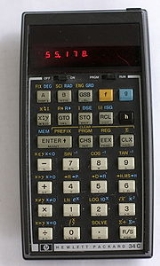
HP-34C
Encyclopedia
Part of the series of HP calculators
. HP-34C Continuous Memory Calculator (1.7.1979 ($150) – 1.4.1983 ($100)) was an Advanced Scientific Programmable calculator that was differentiated by the fact that programs and storage were maintained in memory when the calculator was turned off (continuous memory), unlike most calculators of that time. However this feature had been implemented in the HP calculator line on certain models since 1976.
HP-34C Continuous Memory Calculator (1.7.1979 ($150) – 1.4.1983 ($100)) was an Advanced Scientific Programmable calculator that was differentiated by the fact that programs and storage were maintained in memory when the calculator was turned off (continuous memory), unlike most calculators of that time. However this feature had been implemented in the HP calculator line on certain models since 1976.
and root finding
(a first for any pocket calculator). Integration and root finding worked by having the user input a formula as a program. Multiple roots are found using the technique of first finding a root, then dividing the equation by (1-root value), thus driving the solution of the equation away from the root at that point. This technique for multiple root finding is referred to as "deflation". The user would usually programatically recall the root value from a storage register to improve its precision.
The HP-34C shipped with an "applications" manual that included two games (Moon Rocket Lander, Nimb). This made the calculator probably one of the first pocket game computers ever invented. The winner was announced by turning the display upside down and the words BLISS or I'LOSE (55178 or 3507,1) were written (see Calculator Spelling
for other possible words). A game of blackjack was easily programmable in the 'vast' amount of memory by converting some of the registers to lines of program.
Although it is argued the HP-41C (Introduced late 1979 and only a matter of months after the HP-34C) was a replacement for the HP-34C, they were in fact differentiated as much by price (the HP-34C being 50% that of the HP-41C) as they were by functionality and performance (the HP-41C being the first HP LCD based and Module expandable calculator, with its standard functionality lacking the root-finding and integration capabilities as well as the gamma-function implementation of the HP-34C though). This price difference allowed those with economic constraints to still buy a high end HP (HP-34C) Scientific Programmable within a reasonable cost. As such they were sold side by side for a number of years.
HP calculators
HP calculators are various calculators manufactured by the Hewlett-Packard company over the years.- History :In the 1960s, Hewlett-Packard was becoming a diversified electronics company with product lines in electronic test equipment, scientific instrumentation, and medical electronics, and was...
.

Root Finding and Integration
Significant to the HP-34C calculator was the capability for integrationIntegral
Integration is an important concept in mathematics and, together with its inverse, differentiation, is one of the two main operations in calculus...
and root finding
Root-finding algorithm
A root-finding algorithm is a numerical method, or algorithm, for finding a value x such that f = 0, for a given function f. Such an x is called a root of the function f....
(a first for any pocket calculator). Integration and root finding worked by having the user input a formula as a program. Multiple roots are found using the technique of first finding a root, then dividing the equation by (1-root value), thus driving the solution of the equation away from the root at that point. This technique for multiple root finding is referred to as "deflation". The user would usually programatically recall the root value from a storage register to improve its precision.
Programming
The common method of converting registers to program memory allowed the calculator a maximum of 210 program steps. Programming features such as indirect jumps provided substantial capability to the calculator's programer.The HP-34C shipped with an "applications" manual that included two games (Moon Rocket Lander, Nimb). This made the calculator probably one of the first pocket game computers ever invented. The winner was announced by turning the display upside down and the words BLISS or I'LOSE (55178 or 3507,1) were written (see Calculator Spelling
Calculator spelling
Calculator spelling is a technique of spelling words by reading characters upside-down from calculators equipped with certain kinds of seven-segment displays...
for other possible words). A game of blackjack was easily programmable in the 'vast' amount of memory by converting some of the registers to lines of program.
Pedigree
The calculator endured many long years of useful life and was superseded, in 1982, by the HP-15C.Although it is argued the HP-41C (Introduced late 1979 and only a matter of months after the HP-34C) was a replacement for the HP-34C, they were in fact differentiated as much by price (the HP-34C being 50% that of the HP-41C) as they were by functionality and performance (the HP-41C being the first HP LCD based and Module expandable calculator, with its standard functionality lacking the root-finding and integration capabilities as well as the gamma-function implementation of the HP-34C though). This price difference allowed those with economic constraints to still buy a high end HP (HP-34C) Scientific Programmable within a reasonable cost. As such they were sold side by side for a number of years.

